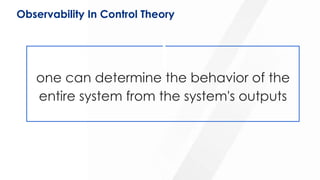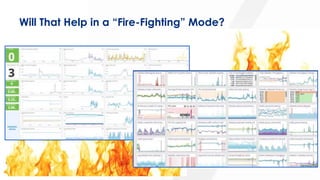Monitoring "unknown unknowns" - Guy Fighel - DevOpsDays Tel Aviv 2017
This document discusses monitoring systems for unknown unknowns using machine intelligence. It suggests that observability goes beyond just monitoring and instrumentation to make systems debuggable and understandable. It outlines several techniques machines could use like anomaly detection, predictions, external knowledge, recommendations, and auto-correlations. The goal is to develop an "observability quadrant" like the Johari window to better understand systems with imperfect outputs. It recommends choosing the right tools, applying common schemas to event data, using techniques like fuzzy logic and similarity checks, and focusing first on simple correlations and time series models before building complex classifiers. The best practices are to start using such techniques in production by getting feedback and continually re-evaluating relevance.





















Recommended




























































More Related Content
Viewers also liked (7)














Similar to Monitoring "unknown unknowns" - Guy Fighel - DevOpsDays Tel Aviv 2017 (20)








































More from DevOpsDays Tel Aviv (20)








































Recently uploaded (20)




































Monitoring "unknown unknowns" - Guy Fighel - DevOpsDays Tel Aviv 2017
- 1. Monitoring “unknown unknowns” With Machine Intelligence
- 2. @guyfig On-Call Engineer by Nature "If a tree falls in a forest and no one is around to hear it, does it make a sound?"
- 3. Observability is a superset between monitoring and instrumentation. Making systems debuggable and understandable @mipsytipsy Do you really know what to observe? Instrumentation - mostly Developer driven What is the output? Dashboard? Exploration tool?
- 4. one can determine the behavior of the entire system from the system's outputs Observability In Control Theory
- 5. Unknown Unknowns - Rumsfeld Quadrant
- 6. -Static thresholds -Defined Alerts -Static Runbooks -Anomaly Detection -Predictions -External Knowledge -Knowledge -Recommendations -Auto Collaboration -Inference -Auto Correlations -Semantic Analysis -Decision making The Observability Quadrant (Based on Johari window)
- 7. Humans Driven Detection Set thresholds to find patterns Simulate based on known Use percentiles, basic stats
- 9. Will That Help in a “Fire-Fighting” Mode?
- 10. Find The Problem Thresholds? Baseline? Anomaly? - Scale matters - Stationary noise matters - Use Autocorrelation
- 12. Independent component analysis (ICA) separates a multivariate signal into additive subcomponents that are maximally independent. from sklearn.decomposition import FastICA, PCA
- 13. Find The Problem CPU 90% Time in Minutes EC2 Instance changed from t2.small to m3.xl Events & context matters Anomly?
- 14. Use Enrichment
- 15. What Can Machines Do? Process different types of data, transform it fast and handle huge amounts in real-time Automate and adapt Anomaly Detection Apply Semantic text similarities to find patterns (Information Retrieval) Apply auto correlation models Evolve and adapt (overtime) based on human interaction
- 16. The Goal - Centralization Observability for systems with imperfect outputs Events enrichments, symptoms detection and inference Automatic Outlier Detection Automatic Correlation Get closer to the Control Theory mathematical definition
- 17. Pick The Right Tools https://github.com/turi-code/SFrame
- 18. - Define the model. Use a single schema (Apache Avro) - Events are agnostic. Can represent logs, stack trace, metric, user action, HTTP event, etc. - Every event should have a set of common fields as well as optional key/value attributes Get a Common SchemaUse Common Schema
- 19. Deterministic models are better to start with (Fuzzy Logic, Rules) Choose your logic and start run it across your data (schema) Apply similarity checks to strings first (TF-IDF, BM25, Fuzzy, other classifiers) Look into correlations, start with simple obvious ones, before building classifiers (Unsupervised/Semi-supervised learning is much more relevant overall) Build your prediction models on time series data first. (Statistics has solid models) Time and context are dimensions you will be able to start addressing Best Practices
- 20. Use It In Production - Your team == your users - Ask for feedback - Re-calculate relevancy - Apply Recommendations based on your own team knowledge


